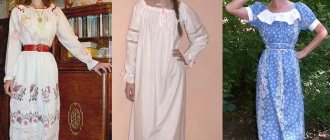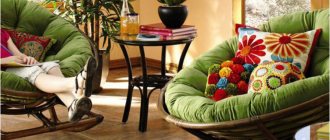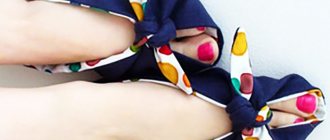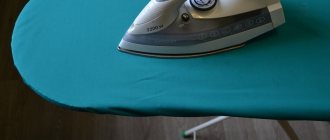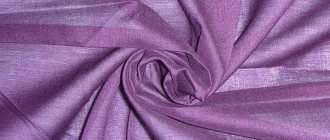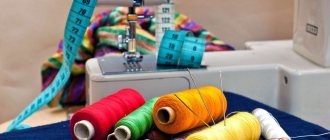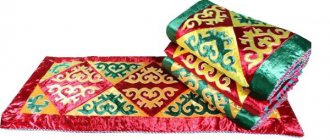/Accessories and decor/Decoration/
What are kitchen towels used for? To keep your hands clean, you say. But this is also one of the important decorative components of the entire room. Moreover, they are easy to make with your own hands, adding the necessary shades or patterns to the interior.
To sew your own towels, you will need very little - a suitable fabric that absorbs moisture well and a sewing machine. Using a simple piece of fabric will require a minimum of effort from you, and if you want to create a handmade textile masterpiece for the kitchen, you can use buttons, ribbons, colored threads, appliqués and patches.
How to sew a beautiful kitchen towel with your own hands as a gift for beginners: ideas, photos
In fact, sewing a towel is not such a difficult job. For the process you will need everything: imagination, material, threads, scissors, machine, needle. If you want it to look different than usual, then you can embroider a real work of art using different colored threads on a regular waffle base or linen fabric.
Even such scraps of colored material, as in the image below in the form of an applique and lush frills at the bottom of the towel, will decorate your kitchen with a festive atmosphere for the New Year.
DIY towel
In almost any home in the closet you can find an old dress made of cotton fabric, which a fashionista will no longer wear, and maybe also pieces of braid and lace. This material will make a towel, and more than one, which can be sewn in the form of a fluffy sundress, as in the photo below.
Kitchen towels made of colored fabric
Instructions for sewing a regular kitchen towel:
- Take the material. Cut out a regular rectangle measuring 62 by 32, leaving two centimeters for hems.
- To get a perfect edge, iron the edges of the product (5 mm twice on each side).
- Secure the folds with needles and stitch the edges using a sewing machine.
- If you don’t want to waste time on hems, then sew the edges with a zigzag.
Kitchen towels with ready-made applique
Decorating an ordinary towel
So, we have threads, a hook and ready-made colored fabric inserts. With just this set you can give ready-made towels clear and bright outlines and unique originality.
Everything is quite simple here:
- Decorate with appliqués;
- And we crochet it around the perimeter.
Cute bells
Advice! In order for the knitted edging to remain juicy and colorful for a long time, it is necessary to check whether the threads will fade when washed in hot water.
However, you should not focus only on the usual rectangular shape. Add a little imagination, just a little skill, and you will no longer be tormented by the question of how to sew a kitchen towel yourself.
Read also the article about kitchen towels.
What fabric are kitchen towels made from?
Potholders and towels are in use all the time in the kitchen and that is why they quickly become unusable. Ordinary rags do not look as attractive as products sewn with love. Before you start cutting towels, you should decide on the material. The fabric should absorb moisture well and wipe dirty surfaces well.
Fabric for kitchen towels
For towels, the most commonly used material is waffle material , which is made from 100% cotton. Thanks to the small squares that are located throughout the material, its hygroscopicity improves.
To ensure that the towel washes well, use terry material . Only fabric with low pile will be convenient for sewing. You can decorate towels made from this base with an insert of another material or with embroidery or applique.
Terry towels
If you prefer bright colors, patterns and textures, then choose chintz and linen for towels. Natural fabrics are good for wiping hands and putting things in order in a room.
IMPORTANT : To make sure your towels don’t look like others, trim them with edge tape, make lush ruffles or stitch lace, and smooth the finished appliqués.
From a pillowcase
You can make 2 or 4 even rectangles from a pillowcase. It's even easier than using a sheet. You need to cut off the buttons or fastener, cut each pillowcase in half or into 4-6 parts. Some housewives decorate napkins with decorative braid and sew on loops. The design is up to your taste.
By the way, if you have an old linen pillowcase, don’t throw it away. Linen lasts a very long time and is not afraid of washing and ironing. In Soviet times, women always ironed even kitchen towels: it was believed that it was such little things that indicated that a tidy housewife lived in the house.
What size are kitchen towels made?
A good housewife always has a lot of oven mitts and different towels in her kitchen. And if a woman is also a needlewoman, then almost all of her things are sewn with her own hands. Moreover, for this you only need a piece of fabric and a pattern is not necessary. After all, this practical item can be made in the form of an ordinary rectangle. There are different sizes. The most convenient towel for hands or for hot pots and pans is a cloth measuring 40 cm by 70 cm or 60 cm by 30 cm .
If there is not so much material or you are sewing a product from the remnants of old clothes, then the size of the fabric can be adjusted. Don't forget to leave one centimeter at a time to decorate the edge of the finished product.
Kitchen towel - how to sew?
Towel options
- Round or oval shape. This may not be entirely practical, but such products will fit perfectly into the kitchen interior. Especially in the one where there are not enough rounded elements in the decor.
- A set of several towels that are fastened together with buttons. If we wind them into a roll, we get something like paper towels, which is quite convenient - we unwind them, use them, and wash them. Hygienic, original and practical.
Good idea - towels with buttons
Advice! It is better to choose buttons in this version from plastic - since iron ones are not practical with frequent washing.
- In the form of a doll. Quite an original solution, where the doll’s dress acts as a towel. It is best to make several of these outfits in advance and change them according to the seasons and holidays. And it’s not difficult to attach it - using buttons. In addition, this is a wonderful gift, and the price will be minimal.
- On a cartoon theme. Such a plot will help instill cleanliness in a little child. And your child will become a frequent guest and helper in the kitchen.
Do I need to fold the edges of kitchen towels?
The shape of the finished towel may vary. For convenience, women sew such products with loops or “purses” with a clasp at the top, on which an unusual towel is hung. The edge of the canvas can be folded (twice), then stitched so that it does not fray. You can simply cover it with a special tape for finishing the edges. The bottom, top and sides of the product are also trimmed with a zigzag or trimmed with other fabric in the form of ruffles, frills, etc.
How to process the edges of a towel?
When processing the edges, so that the corners do not turn out too thick, it is advisable to cut off small pieces of fabric in these places with scissors, then all the folds will come out extremely neat.
If you decide to trim the edge with a special ribbon for this type of work, then choose the color of the ribbon to match the towel itself. Then everything will be in harmony.
Ideas and materials
Home textiles create the mood in the kitchen. Down with ordinary rags - beautiful towels are not that difficult to make yourself, and no worse than store-bought kits. All you have to do is choose the fabric and start transforming an ordinary towel into a stylish and practical decor.
Suitable fabrics
Take a closer look at these fabrics:
- Waffle fabric. This cotton fabric has a textured pattern and is highly absorbent. The material can be white or with a printed pattern; patterns with folk painting - Gzhel and Khokhloma - are especially popular.
- Terry fabric. Choose one that has short, fine pile. It does not leave streaks, is hygroscopic and retains its properties even after frequent washing.
- Linen. Natural fibers also retain water well, do not fade, and are wear-resistant. Plain fabrics withstand frequent washing and boiling well. The disadvantage is that this material wrinkles easily and is difficult to iron.
- Bamboo. A new material loved by housewives because of its soft, pleasant-to-touch surface. It costs more, but also lasts much longer than previous options.
Important! When choosing a fabric, pay attention to the content of synthetic and natural fibers in the composition. Synthetics reduce the ability to absorb water, but also increase the service life of the towel.
Form
Having decided on the choice of fabric, it is worth thinking about the shape. How can you make a towel?
- Traditional rectangular fabric, stitched along the edge.
- Small, compact pieces of fabric sewn at the edges into an envelope are very convenient for wiping dishes. When unfolded, such a dishcloth looks like a pyramid, with a hook loop sewn onto the upper end. This way the entire surface is used as much as possible. The usual situation, as with the previous version of towels, when the center of the sheet becomes greasy, but the edges are snow-white and clean, will not happen.
- An interesting version of the classic towel is large round napkins with a hook, which are also used as potholders.
Important! To prevent kitchen textiles from taking up space on hooks, there are towels with a sewn-on corner or a holder that allows you to hang it on a bar or cabinet door.
Decor options
There are many options for how to decorate a towel with your own hands:
- embroidery;
- painting;
- lace;
- applique;
- patchwork.
As a rule, the decor is placed along the lower edge of the fabric, so it gets dirty less and maintains a neat appearance longer. An original addition to the kitchen set will be hooks made in the shape of soft dolls, fruits and vegetables.
Important! Show originality and make several seasonal sets of kitchen textiles according to the seasons, for family holidays. This way you can quickly give the kitchen a cozy look before the celebration and the arrival of guests.
How many towels do you need in the kitchen and how often should they be washed?
Experienced housewives believe that there should be at least 7 towels for every day of the week. At the same time, towels for dishes, hands and food are sewn separately. At the end of the week, all towels are collected and washed. Towels decorated with decorative trim and embroidery are washed only by hand, in water at 30 degrees, and rinsed thoroughly in water acidified with acetic acid. To dry, the product is rolled up and wrapped in terry cloth. After allowing the excess water to be absorbed, hang it out to dry.
Important! Handmade towels with trim also require careful ironing. In order not to spoil the embroidery when ironing, the iron should be placed on the embroidery for a couple of seconds and then move to another area.
This is interesting: Pattern How to sew a bow
Sewing a towel from terry cloth: ideas
Terry cloth does not get dirty so quickly and is perfect for kitchen work. Having chosen a fabric for sewing a product in the store, do not immediately forget to buy threads, and maybe some other auxiliary materials: appliqués, ribbons, other fabric, braid, buttons for decoration.
Terry towel with embroidery
The towel can be any shape - even an oval. The main thing is that you feel comfortable using it. The edges of the towel look beautiful when they are crocheted in different openwork patterns. Also, the edges are made in the form of small bells from ordinary threads, etc.
Embroidery on terry cloth looks wonderful. It is enough to choose the right image, threads that do not fade and embroider the product with high quality without flaws. Try to ensure that your embroidery is the same on both the front and back sides.
Terry towels for the kitchen
When you decide to make convenient loops so that the towel can be hung on a hook, stove handle or in another place, use ribbons, pieces of fabric, laces, strings, buttons, snaps.
IMPORTANT : Terry fabric can contain not only natural fibers, but also synthetic ones. Thanks to this, towels made from this fabric will have an increased service life.
From a T-shirt
A good opportunity to finally get rid of those boring T-shirts and T-shirts, freeing up space in your closet. Soft materials make the best rags and towels for cleaning; they are convenient for wiping dishes. Lightweight cotton materials absorb water well.
Cut off the sleeves and neck of the T-shirt. Cut randomly, hem the edge. The latter is done so that the edge of the material does not crumble and the item lasts longer.
It is best to use T-shirts without bulky details. If you put something hot on such a napkin, they may be imprinted on the bottom of the hot dish or on the table.
How to sew a waffle matryoshka kitchen towel: patterns, photos
To decorate your home, you can make your own Matryoshka doll from a waffle towel and other auxiliary materials. To do this you will need to make a dress pattern. This pattern is shown in the figure below.
Dress for Matryoshka
You can also use the head, torso and arms of an old doll as material. The dress, made from waffle fabric, ribbons, and chintz inserts, should be the size of your doll.
Matryoshka made of chintz fabric
How to sew a dress?
- Transfer the pattern details onto the fabric, taking into account the seam allowances of the dress.
- Use the fabric rationally, cut out the details of the dress using scissors exactly along the lines.
- There should be five parts in total: two sleeves, two skirt parts and one part with a folded back and front.
- All that remains is to sew the cut details, overcast them, decorate them with beautiful embroidery or stripes, and tuck the bottom of the dress so that it does not fray.
From the tablecloth
A waste fabric or cotton tablecloth will make 10-15 excellent kitchen towels. They look great made from country materials (large checkered). Tablecloth napkins are even suitable for decorative purposes and will be an excellent decoration for the kitchen. If the material is cotton, then it can make a beautiful stand for hot dishes.
- Author: Rada Pakhomova
Rate this article:
- 5
- 4
- 3
- 2
- 1
(18 votes, average: 4.3 out of 5)
Share with your friends!
How to sew an interesting kitchen towel in the form of dresses: ideas, sizes, patterns
Sundress-shaped towels and dresses are sewn without a pattern. At the top they make a yoke in the form of a rectangle from one fabric, for example calico, denim or any other.
At the bottom, it is enough to make a fluffy skirt from a rectangle, tightening it with a ribbon, as in the picture below. Then sew this skirt to the top of the product.
To make the towel convenient to use, make a loop at the top where you can hang it on a hook. Or you can make the top part of the sundress from two parts that fasten like a wallet.
Towel in the form of a sundress
You can decorate the most ordinary towel with embroidery, as in the image below.
Beautiful towel in the form of a summer dress
As you can see, you can decorate a room even with simple things like towels. It will be very pleasant to walk into such a cozy kitchen, where even the oven mitts match the overall interior and delight the eye with their splendor.
From the curtain
If the cat has torn the curtain with its claws, cut off the lace details, sew on a loop - and another useful item is ready. Or you ironed a curtain and set it on fire with an iron - cut out the damaged part, cut it, and hem it. You will get stylish kitchen accessories.
For comparison, at IKEA such things cost 100-200 rubles apiece. Microfiber products are even more expensive.
We sew ourselves
Even sewing beginners can easily master sewing a kitchen towel. Let's start with the simplest option.
Simple waffle towel
For work we will need:
- piece of waffle fabric 61 x 31 cm
- thread to match the fabric
- sewing machine
- lace or braid
It doesn’t matter if you don’t have a sewing machine; you can finish the edges of the towel by hand, using a regular backstitch or hand stitching.
It is no coincidence that we indicated the sizes 61 and 31 cm; we use 1 cm for hemming the towel, so we get the standard 60 x 30 cm. The edges must be folded twice, bending 0.5 cm each. To make them easier to sew on a machine, you can iron bends with an iron or baste them by hand.
First, we sew the edges along the length of the towel, then we sew the bottom and top. We make a loop of the required length from braid or lace and sew it in the middle of one of the long edges of the product. Our towel is ready.
Towel with original holder
If you plan to hang the towel not on a hook, but on a rail, then it should be equipped with a stylish holder. And then we need the following materials and tools:
- a piece of fabric (choose any of the types above) measuring 51 x 31 cm
- 2 pieces of colored fabric 20 x 20 cm
- button
- scissors
- pencil and ruler
- thread in the color of the towel material
- sewing machine
Having measured and cut out the fabric, we begin the main work.
- We hem the main flap on three sides, along two lengths and widths.
- Fold the two holder flaps right sides together. We measure the middle of the top edge, draw two oblique lines from it to the middle of the sides.
- We cut out the parts, adding an allowance of 0.5 mm along the oblique lines.
- We sew the edges, leaving the bottom of the parts unstitched.
- Turn the resulting triangle right side out.
- We measure its width at the bottom.
- We assemble the raw top of the towel into a large gathering so that it is equal in width to the bottom of the holder.
- Sew the top of the towel into the bottom of the holder.
- We sew a linen loop on the triangle.
- We try on the product on the railing and mark the place for sewing on the button.
- Sew on the button.
We have created an original and comfortable kitchen towel.
For a housewife familiar with the patchwork style, we will tell you how to sew a kitchen towel yourself, decorating it with a patchwork finish. Prepare the following materials and tools:
- piece of waffle fabric 51 x 71 cm
- several scraps of colored fabrics, different in pattern and color or combined in color, but with different prints, 12.5 cm wide and 15 cm long
- scissors
- sewing machine
- ruler and chalk or marking pencil
Stages of work:
- We sew a waffle towel following the example of the first lesson.
- We cut the flaps into squares and rectangles, with sides 12.5 x 5 or 12.5 x 10 cm. The length dimensions can be changed at your own discretion.
- We make a long strip, arranging the flaps in random order, but joining them in width.
- We sew the flaps together so that the length of the strip is 1 cm longer than the length of the towel.
- Smooth all edges of the strip.
- Mark on the towel where the strip will be sewn.
- Attach the strip to the main fabric.
In this style, you can sew several towels, placing patchwork strips both along the length of the product and on the transverse line.
A terry towel for the kitchen is inexpensive, stylish and unusual.
Taking as a basis the classic version of a kitchen towel made of linen or waffle and terry fabric, you can radically change its appearance by adding all kinds of decorative details to the fabric.
If you are interested in embroidery, turn your towels into an elegant towel with your own hands. This is what our great-grandmothers and grandmothers did, decorating ordinary linen towels with picturesque ornaments.
If you are familiar with the technique of sewing tilde toys, apply your skill and sew a towel holder in the shape of such a toy.
If you know how to crochet, decorate the edges of the towel with openwork from air loops.
You have a little helper growing up, sew a kitchen towel for her with a funny applique. You can do this together, trusting your child to choose the drawing. To reduce the need to process parts, choose low-fraying material for appliqués. This decor fits very well on terry fabric.
Towel holders provide a lot of room for imagination. They can be made in the form of small potholders, sewing large ones to them, so you get an exclusive set. Use hand-knitted flowers or leaves as holders.
It doesn’t take much time to create a kitchen towel with your own hands, and the materials won’t cost you much. And thanks to your skill and patience, your kitchen will receive an unusual and stylish decorative element that no one else has.
Greetings to all needlewomen who love to sew to create comfort in their home) Today I want to invite you to sew a kitchen towel with your own hands using the patchwork technique. This type of towel is interesting because it can be hung on the handle of a gas stove, which is very convenient in the kitchen. The towel can be waffle or terry; you can remake an existing one or purchase fabric in the store. And to sew a colored towel top, you can use scraps of fabric available in the house or old unnecessary clothes. A handmade towel will decorate your kitchen interior, will help you in preparing dishes and washing dishes in the kitchen, and to keep the whole house clean, I suggest purchasing an irreplaceable thing that has won the hearts of many housewives - a robot vacuum cleaner. In the official irobot online store you can purchase an intelligent robot vacuum cleaner from an official representative at the most reasonable prices to date.
So, to sew a kitchen towel we will need:
- waffle or terry fabric,
- cotton printed fabric for finishing,
- sewing machine,
- threads,
- needles,
- buttons,
- scissors.
Below you see a pattern for the top of the towel; it needs to be printed on a printer or transferred from the monitor screen.
We start sewing the towel from the top
For the bottom of the towel, cut out a rectangle of fabric and process three sides of it, hem it with a sewing machine
We fold the prepared lower part of the towel and insert it into the upper decorative part
All that remains is to make a loop and sew on a button
We often throw away old things and don't even look for alternative ways to recycle them and use them for other purposes. With just a little imagination, all the things you threw away before will get a new life.
For example - towels. Bath and beach towels degrade quickly and need to be replaced, but instead of throwing them away, try some of these simple makeovers.
1. Lemon and dust cloths
Lemon and dust cloths are great for cleaning hard surfaces. You will need: old towels or washcloths, lemon, vinegar, olive oil, water and an airtight jar or container.
First, cut your towels to fit your washcloth. Next, mix white vinegar and water with olive oil in a bowl, and soak rags in the mixture.
Place rolled or folded towels in an airtight container and store them until you need them. Simply open the jar, discard the lemon zest and use.
2. Bath slippers
You can transform any pair of slippers or flip-flops into luxurious fluffy slippers with just the help of a towel. Make the correct patterns and sew a towel on slippers.
3.Reusable mop brush cover
To avoid buying disposable mop covers, you can sew them from old towels. First, measure the fabric to the size you need and cut out the towels.
Sew the edges and place tightly on the mop. Create several pieces to change if necessary.
4. Braided rug
Old towels can be turned into a thick fluffy rug with a few simple steps. Fold the towel and cut 1.5-inch strips.
Take three strips and sew the ends together, then braid them all the way to the end. Continue until you have a long rope.
Curl the rope like a spiral and, using strong thread, sew them together. You can braid the same rug with different colors.
5.Fabric bathroom holder
If your bathroom is a little cluttered, you can use an old towel and make a fun holder. To start, take an old towel and simply fold 1.5 inches over the top. Pin and sew the flaps like pockets.
Fold the towel one more time and sew the bottom edge of the pockets!
6. DIY dust cloth
You only need an old towel, a wooden dowel, scissors, Velcro, and a silicone gun to create this DIY dust collector.
Start by cutting the towel into a square. Place the dowel in the middle of one square, then apply a little glue to the outer parts and place the other square on top of it.
Then cut several strips, tying each one around a dowel. Finally, secure the Velcro around the dowel.
Now you can start cleaning! Simply remove the Velcro from the towel and get started.
7.Fluffy rug
To make a shaggy rug, you only need three things: old towels, rubber mesh and scissors.
Cut the towels into small strips and thread each strip onto the rug, tying in knots to secure.
Repeat the process until the entire grid is filled with stripes. You will have the most shaggy and fluffy bathroom rug.
8.Baby bib
Making a baby bib is very simple. Just take an old towel and make a hole the size of a regular disc.
Learn how to sew your own kitchen towels. These hand-sewn products will appeal to housewives who like their home to be decorated in an original way.
No housewife can do without oven mitts and towels in the kitchen. Keeping your hands clean is important, but that's not the only function they serve. Towels also play a big role in the decor of the room. The room will look much more cheerful if you sew such napkins with your own hands from a suitable fabric with different decorations in the form of ribbons, embroidery, appliqué, patches with bright patterns.
Grandmother's towel with lace
The rustic style has not lost ground and is still popular. Antique linen embroidered towels with red roosters and lush flowers were considered amulets that protected the house and residents from the evil eye. Not every housewife will decide to use such a beautiful towel in everyday life. You can sew a modern analogue, simpler, but no less beautiful. This Retro style towel will definitely take pride of place in your kitchen.
This is how you can do something like this:
- Prepare a linen piece of fabric, overcast the side edges.
- Place a traditional or stylized pattern along the edge. There are many motifs to choose from for cross stitch or satin stitch - find one that suits you and transfer it to the fabric. Using the previous tips, you can paint the fabric with fabric paints.
- Having finished the embroidery, we begin to process the lower edge with lace. Take a wide cotton lace braid and sew it to the edge of the product. To prevent the ends of the lace from unraveling, sew them and turn them inside out.
Important! Lace made from natural threads will shrink when washed. Before work, wash it and iron it. You can decorate a towel with shrunken braid without fear that it will ruin the finished product.
What you will need to make your own
The minimum required set looks like this:
- a small amount of suitable fabric;
- sewing machine (you can do it manually if you don’t have one - the amount of sewing is small);
- threads, pins, scissors;
- if desired, decorative elements: ribbons, sewing, buttons, braid, etc.
A kitchen towel will have to take on a lot, and the fabric will get washed often. Therefore, practicality is its necessary quality.
ADVICE! Colorful colors are ideal - inevitable stains will be less noticeable.
Cotton and waffle towels cope best with the main requirements - to absorb moisture well and dry quickly . The latter are also a variant of cotton fabric. But, thanks to special processing, they are more hygroscopic: tiny squares do an excellent job of this. Both linen and thin terry cloth are possible .
IMPORTANT! Linen towels will gain the desired softness only after several washes. Until then, they can take on the “ceremonial” function.
Types of finishing
Since we are going to sew our own kitchen towels, it is right to give them some personality. The good thing about the work is that it allows you to experiment. On an industrial scale, towels are sewn according to predetermined patterns, but we can deviate from the clichés and create products to suit our own tastes and desires.
Such types of needlework as embroidery, applique, and patchwork are suitable for finishing. In addition, towel holders made of the same material or sewn in the shape of a doll can serve as decoration. Towels with knitted loops and holders made of contrasting fabric material look stylish. The edges of the product are trimmed with braid or fabric of a different shade.
Actually, everything you know in terms of home crafts, you can use to decorate a kitchen towel. In addition, it is possible to deviate from the classic shape of the product. Why not make it oval or round if you really want to. How practical it will be, decide during operation, and maybe you will like it.
Some housewives equip their creations with plastic buttons and do not hang them on hooks, but roll them up. Some decorate them with lace, but for others this is not enough, and they create real works of art by decorating the edges of the towel with funny rag animals. In any case, build on your capabilities in sewing and handicrafts.
Types and properties of waffle textiles
This material is made only from cotton, less often flax (although cheap Chinese-made products may also contain synthetic fibers). A special combined weave of threads creates a relief of cells on the front side with raised borders and a deepened middle. This texture increases the total surface area, as a result of which it intensively absorbs moisture, removes dirt from the surface well, and also massages the body. The wafer fabric presented on the market can have a density value from 80 to 240 g/sq.m.
The denser the waffle fabric, the higher its quality is considered, and the more expensive it is.
The main properties of this textile are:
- naturalness;
- hypoallergenic;
- environmental cleanliness;
- high hygroscopicity;
- breathability;
- thermal insulation properties;
- durability;
- strength (depending on density);
- possibility of processing at high temperatures;
- lack of lint when wiping;
- low price.
According to the type of processing, wafer fabric is divided into:
- Severe, which is made from unbleached threads. It has a gray-beige color, is quite hard and absorbs water worse than waffle fabric of other categories, therefore it is used for technical purposes or as a semi-finished product for further processing.
- Bleached, obtained from harsh material. This is the most common waffle fabric and has a wide variety of uses. It has high absorbent properties and is quite soft when touching the skin.
- Plain dyed, which is obtained by dyeing bleached. It has a beautiful color, although it is not washable at high temperatures.
- Printed, onto which various designs are applied.
Depending on the production method, the wafer sheet can have a width from 45 to 80 cm. In addition, it differs in the size of the cells, the side of which can be from 1 to 10 mm. Fine mesh textiles have a low density and are soft, and are used for personal and kitchen towels because they absorb moisture well and do not chafe the skin. Material with a medium cell size is used for various towels, cleaning textiles, and napkins for technical purposes. The coarse-mesh “wafer” is very dense and quite tough. It is well suited for massage towels, bathrobes, shoes, and bath accessories.
